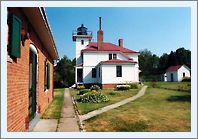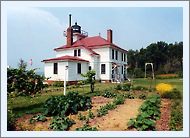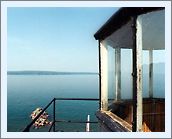|
Historical Information

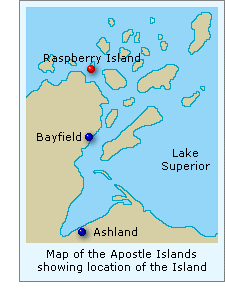 As
the volume of maritime commerce increased through the late
1850's, the maritime community united to request the placement of a
light at the western end of the Apostles to serve as a guide for vessels
out of Duluth attempting to thread their way through the islands on
their way to the ports of Bayfield and Ashland. Sitting 1 ½ miles off
the mainland, and at a diminutive mile in length, and ½ mile in width
at its widest point, Raspberry Island was one of the smallest of the
islands in the archipelago. However, its was deemed to be the natural
location for the Apostles second lighthouse, since a light on the bluff
at the southwest point of the island would serve double duty by showing
the way to westbound vessels passing Bayfield, and guiding eastbound
vessels between Bear and York Islands, and into the channel around the
mainland to Bayfield. LaPointe and Ashland below. As
the volume of maritime commerce increased through the late
1850's, the maritime community united to request the placement of a
light at the western end of the Apostles to serve as a guide for vessels
out of Duluth attempting to thread their way through the islands on
their way to the ports of Bayfield and Ashland. Sitting 1 ½ miles off
the mainland, and at a diminutive mile in length, and ½ mile in width
at its widest point, Raspberry Island was one of the smallest of the
islands in the archipelago. However, its was deemed to be the natural
location for the Apostles second lighthouse, since a light on the bluff
at the southwest point of the island would serve double duty by showing
the way to westbound vessels passing Bayfield, and guiding eastbound
vessels between Bear and York Islands, and into the channel around the
mainland to Bayfield. LaPointe and Ashland below.
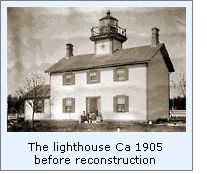 Congress
appropriated $6,000 for constructing the station on March 3, 1859, and a
work crew was dispatched to begin construction on the island during the
1862 navigation season. Work continued through year until winter's
ravages made continuation impossible, and resumed the following spring.
The new structure consisted of a two story, single family wooden frame
dwelling with a short square wood tower located at the center of the
roof apex. Access to the tower was through a set of steps through the
attic located at the top of the second floor landing. Atop the tower, a
copper-covered wooden gallery was constructed with a decagonal cast iron
lantern installed at its center. The district lampist arrived at the
station to install the station's Fifth Order
Fresnel, and carefully
adjusted the clockwork rotational mechanism to ensure that the lens
rotated at the precise speed to exhibit the station's chosen
characteristic of a fixed white light varied by a white flash every 90
seconds. The lens stood at a point twenty-seven feet above the
building's foundation, and by virtue of its location atop the bluff
boasted a 77 foot focal plane, affording a visible range of 15 ½ miles
in clear weather. Congress
appropriated $6,000 for constructing the station on March 3, 1859, and a
work crew was dispatched to begin construction on the island during the
1862 navigation season. Work continued through year until winter's
ravages made continuation impossible, and resumed the following spring.
The new structure consisted of a two story, single family wooden frame
dwelling with a short square wood tower located at the center of the
roof apex. Access to the tower was through a set of steps through the
attic located at the top of the second floor landing. Atop the tower, a
copper-covered wooden gallery was constructed with a decagonal cast iron
lantern installed at its center. The district lampist arrived at the
station to install the station's Fifth Order
Fresnel, and carefully
adjusted the clockwork rotational mechanism to ensure that the lens
rotated at the precise speed to exhibit the station's chosen
characteristic of a fixed white light varied by a white flash every 90
seconds. The lens stood at a point twenty-seven feet above the
building's foundation, and by virtue of its location atop the bluff
boasted a 77 foot focal plane, affording a visible range of 15 ½ miles
in clear weather.
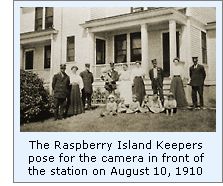 Work
was close to completion in July, and appointed as Raspberry Island Light
Station's first Keeper, Andrew Cramer arrived on July 11, and set about
moving his family and their worldly belongings into the freshly painted
dwelling. Cramer climbed the tower stairs to exhibit the station's light
for the first time on the evening of July 20, 1863. Evidently Cramer was
not suited for the life of an island keeper, as he was removed from the
position on October 16 of that same year, to be replaced by William J.
Herbert. Work
was close to completion in July, and appointed as Raspberry Island Light
Station's first Keeper, Andrew Cramer arrived on July 11, and set about
moving his family and their worldly belongings into the freshly painted
dwelling. Cramer climbed the tower stairs to exhibit the station's light
for the first time on the evening of July 20, 1863. Evidently Cramer was
not suited for the life of an island keeper, as he was removed from the
position on October 16 of that same year, to be replaced by William J.
Herbert.
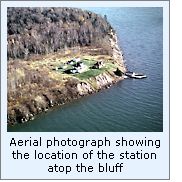 A
work party arrived on Raspberry Island in 1868 to quarry stone to place
around the base of the LaPointe Light on Long Island, which was in
danger of toppling as a result of the sand being blown away from the
foundation. Also in this year, it was determined that the interior
plaster work in the Raspberry Island dwelling was cracking and peeling
badly, and the Lighthouse Board recommended that funds be allocated to
allow a complete re-plastering and painting. At this time it was also
recommended that a boat dock be constructed, along with steps leading
the forty foot bluff to the station. This work was accomplished the
following year, making trips to and from the island much simpler for
then Keeper Lewis Larson. A
work party arrived on Raspberry Island in 1868 to quarry stone to place
around the base of the LaPointe Light on Long Island, which was in
danger of toppling as a result of the sand being blown away from the
foundation. Also in this year, it was determined that the interior
plaster work in the Raspberry Island dwelling was cracking and peeling
badly, and the Lighthouse Board recommended that funds be allocated to
allow a complete re-plastering and painting. At this time it was also
recommended that a boat dock be constructed, along with steps leading
the forty foot bluff to the station. This work was accomplished the
following year, making trips to and from the island much simpler for
then Keeper Lewis Larson.
After implementations of steam operated
fog signals in a number of stations on the Lakes, the Lighthouse Board
recommended that such a signal be erected at Raspberry Island in its
1881 report.
 In
the early hours of September 13th, 1887, Francis Jacker was serving
alone at the station and became aware of a strong west wind kicking up.
Realizing that the station boat was anchored near the dock, and thus in
danger of being blown away, he decided to sail the boat around the lea
side of the point. As Jacker pulled the anchor, the wind picked up to
gale proportions, and he was unable to control the boat, and found
himself being pushed away from the island to crash onto the rocky shore
of Oak Island to the east. Dressed in light clothes, Jacker huddled cold
and without food for three days as the wind blew, and watched his boat
being smashed repeatedly against the rocks. Jacker knew that without an
assistant back at the station, the light would have run out of fuel by
the first morning, and he was faced with the dual worry of possibly
dying of exposure on Oak Island, or being severely disciplined for
allowing his light to burn out. As luck would have it, Jacker's wife was
delivered to Raspberry Island on the 15th, and finding Jacker was
absent, managed to re-light the lamp, but could not figure out how to
get the clockwork rotational mechanism operating. Fortunately, an Indian
passing Oak Island saw Jacker's furtive waves, and delivered him to the
light station, where Jacker and his wife no doubt had an emotional
reuniting. Jacker reported the incident to the District Inspector, and
rather than finding himself in the deep trouble he feared, was rewarded
by official permission to hire his son Edward as his assistant on
December 1. In
the early hours of September 13th, 1887, Francis Jacker was serving
alone at the station and became aware of a strong west wind kicking up.
Realizing that the station boat was anchored near the dock, and thus in
danger of being blown away, he decided to sail the boat around the lea
side of the point. As Jacker pulled the anchor, the wind picked up to
gale proportions, and he was unable to control the boat, and found
himself being pushed away from the island to crash onto the rocky shore
of Oak Island to the east. Dressed in light clothes, Jacker huddled cold
and without food for three days as the wind blew, and watched his boat
being smashed repeatedly against the rocks. Jacker knew that without an
assistant back at the station, the light would have run out of fuel by
the first morning, and he was faced with the dual worry of possibly
dying of exposure on Oak Island, or being severely disciplined for
allowing his light to burn out. As luck would have it, Jacker's wife was
delivered to Raspberry Island on the 15th, and finding Jacker was
absent, managed to re-light the lamp, but could not figure out how to
get the clockwork rotational mechanism operating. Fortunately, an Indian
passing Oak Island saw Jacker's furtive waves, and delivered him to the
light station, where Jacker and his wife no doubt had an emotional
reuniting. Jacker reported the incident to the District Inspector, and
rather than finding himself in the deep trouble he feared, was rewarded
by official permission to hire his son Edward as his assistant on
December 1.
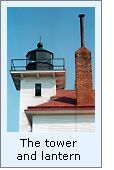 The
lighthouse tender AMARANTH arrived at the station with a work party and
materials for the construction of a new landing, boat house, stairway up
the face of the bluff, and the laying of 327 feet of wood-planked
walkways. The district Lampist also arrived to install new bearings in
the lamp and make adjustments to allow faster rotation of the lamp to
change the characteristic to a fixed white light varied by a flash every
minute. The lens was also equipped with an improved kerosene-powered
lamp, which afforded the light a 350 candlepower fixed light with a
100,000 candlepower flash, which increased its range of visibility to 16
miles.. The
lighthouse tender AMARANTH arrived at the station with a work party and
materials for the construction of a new landing, boat house, stairway up
the face of the bluff, and the laying of 327 feet of wood-planked
walkways. The district Lampist also arrived to install new bearings in
the lamp and make adjustments to allow faster rotation of the lamp to
change the characteristic to a fixed white light varied by a flash every
minute. The lens was also equipped with an improved kerosene-powered
lamp, which afforded the light a 350 candlepower fixed light with a
100,000 candlepower flash, which increased its range of visibility to 16
miles..
 With
the dawn of the new century, major changes were underway at the station.
The landing was again replaced and extended in 1901. 1902 saw the
installation of 120-feet of sewer pipes, and 50 feet of drain tile
around the kitchen. Storm houses were built at the front and rear
entrances, and work on the construction of a brick fog signal to the
east of the dwelling was begun. A combination cast concrete stair and
tramway was built up the bluff to the fog signal to allow the
transportation of building materials, supplies, and the tons of coal
that would be consumed by the steam engines which would be installed to
power the duplicate fog whistles. Contracts for the boilers and whistles
were let, and a brick oil house of 360 gallons capacity was built at the
eastern end of the fog signal building. The lighthouse tender AMARANTH
delivered the boilers, plumbing and mechanical equipment for the fog
signals were delivered in 1903, and the fog signal declared ready for
operation on September 1 of that year. With the significant increase in
workload represented by the activation of the fog signal, Keeper Charles
Hendrickson was given permission to hire a 2nd Assistant to work with he
and 1st Assistant Henry Baker. To this end, Robert Davenport was
appointed to the position, and reported for duty on November 8. With
the dawn of the new century, major changes were underway at the station.
The landing was again replaced and extended in 1901. 1902 saw the
installation of 120-feet of sewer pipes, and 50 feet of drain tile
around the kitchen. Storm houses were built at the front and rear
entrances, and work on the construction of a brick fog signal to the
east of the dwelling was begun. A combination cast concrete stair and
tramway was built up the bluff to the fog signal to allow the
transportation of building materials, supplies, and the tons of coal
that would be consumed by the steam engines which would be installed to
power the duplicate fog whistles. Contracts for the boilers and whistles
were let, and a brick oil house of 360 gallons capacity was built at the
eastern end of the fog signal building. The lighthouse tender AMARANTH
delivered the boilers, plumbing and mechanical equipment for the fog
signals were delivered in 1903, and the fog signal declared ready for
operation on September 1 of that year. With the significant increase in
workload represented by the activation of the fog signal, Keeper Charles
Hendrickson was given permission to hire a 2nd Assistant to work with he
and 1st Assistant Henry Baker. To this end, Robert Davenport was
appointed to the position, and reported for duty on November 8.
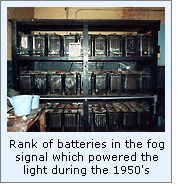 With
three keepers assigned to the station, over 1906 and 1907, the main
lighthouse building was significantly modified and enlarged to create a
true duplex dwelling. When complete, little of the old structure
remained, other than some inner foundation walls and the short tower
atop the roof. A small wood-framed 2nd Assistant's cottage was also
built next to the barn to the rear of the station. With
three keepers assigned to the station, over 1906 and 1907, the main
lighthouse building was significantly modified and enlarged to create a
true duplex dwelling. When complete, little of the old structure
remained, other than some inner foundation walls and the short tower
atop the roof. A small wood-framed 2nd Assistant's cottage was also
built next to the barn to the rear of the station.
The station was electrified in 1928
through the installation of a 23 kilowatt diesel driven electric
generator in the fog signal building. The steam engines and whistles
were replaced with a pair of Type T diaphone fog signals operated by
twin diesel powered air compressors in 1933..
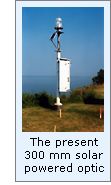 Finally, in 1952, the light was
automated through the installation of a series of batteries in the fog
signal to power a low voltage light on a squat pole in front of the old
lighthouse. The station's Fifth Order Fresnel was removed from the
lantern, and was disassembled for placement into storage. At some time
thereafter, the lens was placed on display in the Madeline
Island Historical Museum, where it remains on display to this
day. The old battery system in the fog signal building was subsequently replaced by a solar
powered 300 mm acrylic optic atop the
pole, which continues to
light the island to this day. Finally, in 1952, the light was
automated through the installation of a series of batteries in the fog
signal to power a low voltage light on a squat pole in front of the old
lighthouse. The station's Fifth Order Fresnel was removed from the
lantern, and was disassembled for placement into storage. At some time
thereafter, the lens was placed on display in the Madeline
Island Historical Museum, where it remains on display to this
day. The old battery system in the fog signal building was subsequently replaced by a solar
powered 300 mm acrylic optic atop the
pole, which continues to
light the island to this day.
Over the final decades of the twentieth century, the
rate of bluff erosion in front of Raspberry and Outer Islands increased
dramatically, with the station buildings being many feet closer to the
edge of the bluff than when they were built. Fearing that if left
unchecked, these historically significant structures would topple into
the lake, Congress appropriated funds to reconfigure the bluffs to stem
the erosion.
Of the two stations, it was deemed that the erosion
situation was most critical at Raspberry Island, and thus work was
planned to begin there in the summer of 2002, with work on Outer Island
planned for the following years. Click
here for a description of the work to be performed, and
photographs of the progress during our visit to the island in July of
2002.

Keepers of
this Light

Click here
to see a complete listing of all
Raspberry Island Light keepers compiled by
Phyllis L. Tag of Great Lakes Lighthouse Research.

Seeing this Light

For five
days in July, 2002, we were privileged to serve as NPS volunteers,
assisting Park Historian Bob Mackreth in documenting the condition of
all the Apostle Islands Lights. We visited Raspberry Island early
in the morning of the fifth day of the trip, and were happy to see that
the stabilization of the bluff in front of the fog signal was well
underway. Click here to see what was going on with project during our
visit.
The Raspberry Island station is one of the few stations remaining with
its boathouse intact, and visitors tying up at the dock get a good look
at the structure before climbing the concrete combination stairway and
tramway which leads up the bluff. The first thing that we noticed when
reaching the top of the bluff was the large number of buildings making
up the station. In addition to the double dwelling and fog signal
building, there is a brick oil house and a wood framed barn, two
privy's, a storage shed, and a small assistant keeper's dwelling, which
appears to be a duplicate of the assistant's dwelling on St.
Helena Island.
Since we were on NPS business, we were able to enter the fog signal, and
explored throughout the building. The building is now used as a storage
area for the park employees, since all of the old diaphone equipment has
long been removed.

Finding this Light

Raspberry Island ins the easiest to visit of all the Apostle Island
lights. Having the deepest and most sheltered dock of all the islands,
private boats can almost always be assured of a place to tie up for a
visit. Apostle
Island Cruise Service operates a Raspberry Island Shuttle
service which departs from Bayfield at 11.30 am, returning at 3.00pm.
The docks at Raspberry Island giving passengers an hour to take a
complete Ranger-lead tour of the station. During the annual three week
Keeper of The Light Celebration in September, two shuttle trips to
Raspberry Island are offered.

Contact information

Apostle Island Cruise Services may be contacted at the following address:
P.O. Box 691 - City Dock
Bayfield, WI 54814
Telephone: (800) 323-7619
Email: info@apostleisland.com
For information on the Keeper
Of The Light Celebration, contact:
PO Box 990 19 Front St.
Bayfield, WI 54814
Telephone: (800) 779-4487

Historical
references

 Annual reports of the lighthouse Board, various, 1859 - 1909 Annual reports of the lighthouse Board, various, 1859 - 1909
Annual reports of the Lighthouse Service, various, 1910 - 1953
Great Lakes Light Lists, various, 1876 - 1977
Annual reports of the Lake Carrier's Association, various, 1906 -
1940
Photograph courtesy of
Photographs taken by the author in July, 2002.
Historic and recent photographs courtesy of the Apostle Island Lakeshore.
Email correspondence with Bob Mackreth NPS, various, January &
February 2002
Keeper listings for this light appear
courtesy of Great
Lakes Lighthouse Research
|
